


The Adriatic city of Split has something to please everyone: the substantial remains of a fascinating Roman palace, wide ocean views, fabulous food and wine, and exquisite tiny ancient churches.

On the shores of the Adriatic Split has grown around the palace built by Diocletian for his retirement. We stayed in the Hotel Slavija which is inside the palace!

There was a Roman settlement here prior to Diocletian building his palace in 295 AD, ready for his retirement to his native Illyria.
Diocletian became emperor in 284 AD at the age of 39 and retired 21 years later, dying at the age of 67 in 312 AD.
The palace measured 200m by 240m and housed a military garrison as well as the luxurious apartments.



Diocletian ruled with a co-emperor Maximian - himself in the east, Maximian in the west. Later he established a tetrarchy adding two junior co-emperors, who were also the emperors' successors. This system was designed to deter assassins because a successor was ready to take control when a senior emperor died.
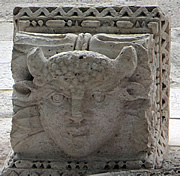


This northern gate was the main entrance to the city, the road from here once led to Solin (Roman Salona) where Diocletian may have lived as a boy, the son of slaves.
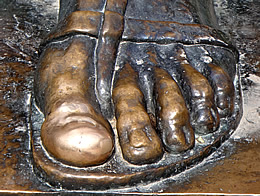
Four gates allowed entry to the palace: the Golden Gate on the north side, Iron Gate to the west, Silver Gate to the east, and Brass Gate to the South - the metallic names were given to the gates by the Venetians who took control of Split early in the fifteenth century.

We learned from our guide that cravats come from Croatia: when their men went to war the wives tied a cloth round their husband's neck so that they could recognise each other when they were fighting alongside other armies and also to remind them of Croatia.




Diocletian's mausoleum in the south-east quarter of the palace complex was converted into a church in the seventh century by Bishop John of Ravenna and is now the city Cathedral of St. Domnius.



The octagonal cathedral is surrounded by a series of original Corinthian columns. The 60m bell tower is much later, begun in the 13th century and taking over 300 years to complete.
At the entrance to the cathedral from the peristyle are two beautiful Romanesque lions, both carrying figures on their backs.





We climbed the bell tower for very good views over the city and then visited the Temple of Jupiter - now the Baptistry, which is on the western side of the peristyle. The south west quarter of the palace held three temples as well as baths and the emperor's living quarters and main reception room - his dining room, the triclinium, was on the south east side.






The Temple of Jupiter, though built in Diocletian's time, has artefacts within from later periods including a beautiful 11th century font with a carving of a subject grovelling before an enthroned ruler. The style of geometric design on font and 11th century sarcophagus is very celtic in nature, very attractive.
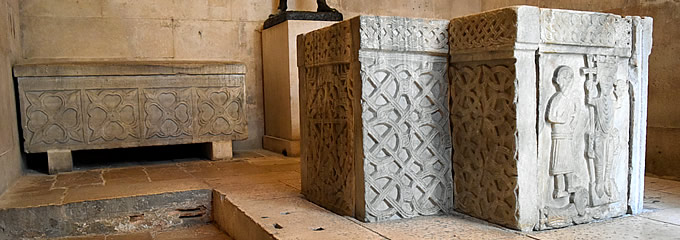


Beneath Diocletian's platform on the peristyle is an entrance to an underground area, also accessible from the Bronze gate. The arrangement of the basement rooms is identical to that of Diocletian's apartments above.


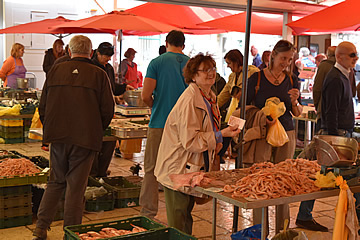
We learned a lot on our walking tour of the city with Split Walking Tours. We combined a history tour with their culinary tour so we began by visiting the fish market to the west of the palace where we chose seafood to be cooked for our lunch: scampi, 4 red mullet, 1 wild sea bream, and bonito.




A little culinary history along the way while we explored the markets and chose food - in the green market near the seafront east of the palace we picked up cherries for dessert. Everything looked fresh and appetising, lots of herbs, dried fruits and plants for sale too.

There is a covered and outdoor section - outdoors there seemed to be more smaller producers, farmers and their wives.


We took the lunch ingredients to Diocletian's Wine House and gave them to the chefs with whom we had a discussion about the kinds of dishes we like. Croatians traditionally have four meals a day, with the main one around lunch time.
After dropping off our food we were taken to the Golden Gate to meet the guide who was to give us the historical tour of the city.
When the tour was finished we were taken back to Diocletian's Wine House. In front of the restaurant is said to be the spot where Emperor Julius Nepos (from whence nepotism comes) was assassinated, heralding the end of the Roman Empire.

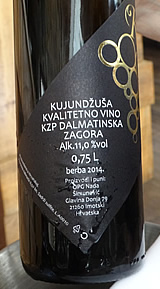

Our lunch was fabulous! A fantastic green pasta starter with the scampi, then the grilled fish - the bonito was stunningly good! And a fabulous cherry crumble to finish. We had an excellent wine and took our time - extremely enjoyable!
We made a point of congratulating the chefs on making such a magnificent meal from our chosen ingredients.




We explored Split quite a bit on our own, wandering the atmospheric alleyways, especially the medieval streets west of the palace.













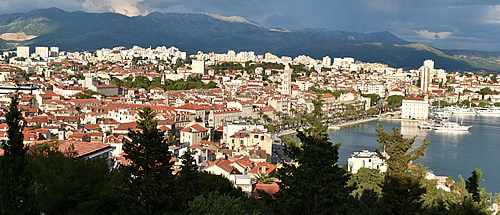



We wandered west of Split and onto the Marjan peninsula, an extensive wooded area surrounded on three sides by the sea.
The outer Split suburb of Veli Varos is one of the oldest and the little church we came across here dates from the 11th or 12th century. Called St. Mikula by the locals, it is more formally named St Nicholas ad pedes montes (at the foot of the hill).1
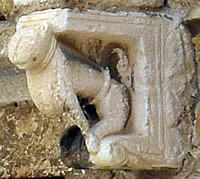

It was built by Ivan and his second wife Tiha
Climbing up we quite quickly came to a more famous church: Sv Nikole Putnika - St. Nicholas of Travellers. It was built in 1219 by another citizen of Split: Rake and his wife Elizabete.


St. Nicholas is the patron saint of sailors and this church could have been seen from the sea - the views from here are spectacular.
